Last Updated on March 23, 2025 by David Nikel. Originally published on December 5, 2023.
Hamar is an expanding town on the shores of the tranquil Lake Mjøsa, Norway’s biggest lake. Here’s an introduction to the town.
After living in Norway for more than ten years and running this website for much of that, it sometimes feels like I’ve seen the entire country. Far from it! There’s so many more places to discover.
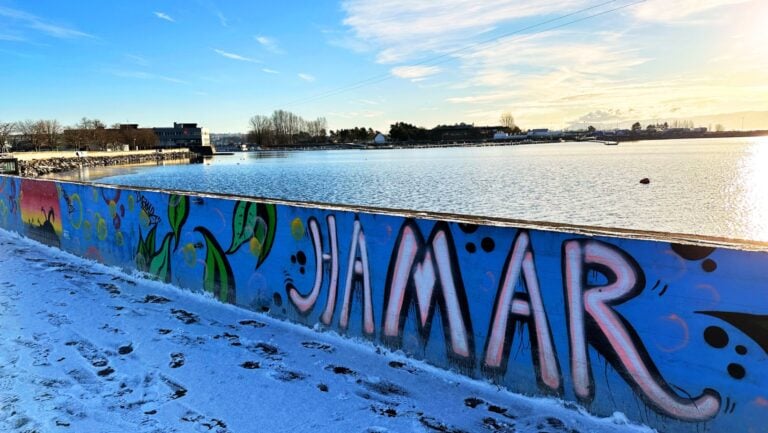
Hamar is somewhere that has been on my radar for a while. One of the first people I met on Twitter through this blog lives in Hamar, as does a good friend of mine here in Trondheim. Yet I’d only ever passed through on the train.
Recently I took the opportunity to visit. I was there during a very cold snap in November, but I will still able to see some of the highlights of the city.
The Basics of Hamar
Only about 30,000 people live in Hamar, but it’s one of the biggest cities in Norway that isn’t on the coastline. The reason Hamar exists where it does is Lake Mjøsa, Norway’s biggest lake, and a defining feature of the city.
The lake played an important role in Hamar’s success as a trading post during the early middle ages. The city also had important religious status with an impressive cathedral, the ruins of which can be visited today.
Formerly the administrative centre of Hedmark county, Hamar is now part of the bigger Innlandet county. It’s about a 126 km (78-mile) drive north of Oslo.
The History of Hamar
The foundation of Hamar dates back to between the years 500 CE and 1000 CE, near the Åker farm. Notable early mentions include coins from the era of Harald Hardråde inscribed “Olafr a Hamri.”
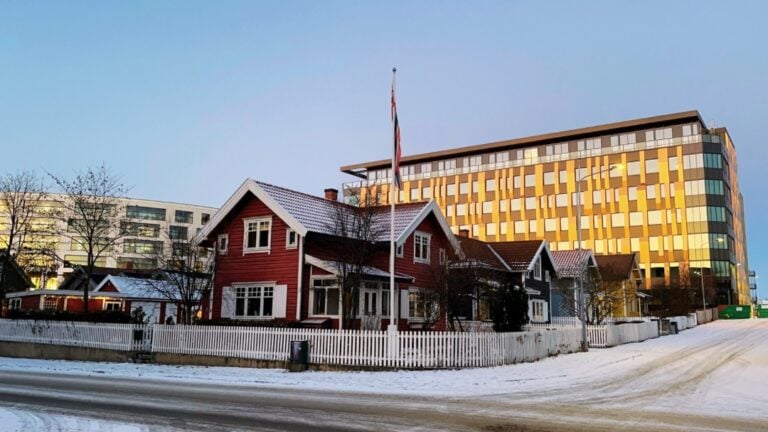
The town’s location shifted to the Rosenlundvika peninsula before 1152, likely under Harald Hardråde’s influence.
After Norway's Christianisation, Hamar rose as a religious centre. Hamar flourished in the early 14th century, marked by the Hamar Cathedral, a bishop's manor, and a fortress. It was a hub for trade, religion, and was renowned for its apple orchards.
However, Hamar suffered during the Black Plague in 1349 and continued to decline, culminating in the Reformation (1536-1537), which led to the loss of its diocesan status. The Swedish army’s siege in 1567 further damaged the town.
Following the shifting of trade to Oslo, efforts to reestablish Hamar as a trading town grew in the mid-19th century. A new city was built near the medieval Hamar with a distinctive urban plan, and it expanded rapidly. The new Hamar Cathedral was consecrated in 1866.
After seeing off floods and fires, Hamar continued to expand in the 20th century, as parts of neighbouring municipalities were incorporated into the city.
Things to do in Hamar
Even though it dropped to -14C while I was there, I was still able to get out and about and see at least some of the city.
Mjøsa Waterfront
Dressed in its winter coat, Hamar waterfront was a pleasant place for a stroll. Everyone was dressed properly for the weather, and I wasn’t the only person out and about. Far from it, in fact.
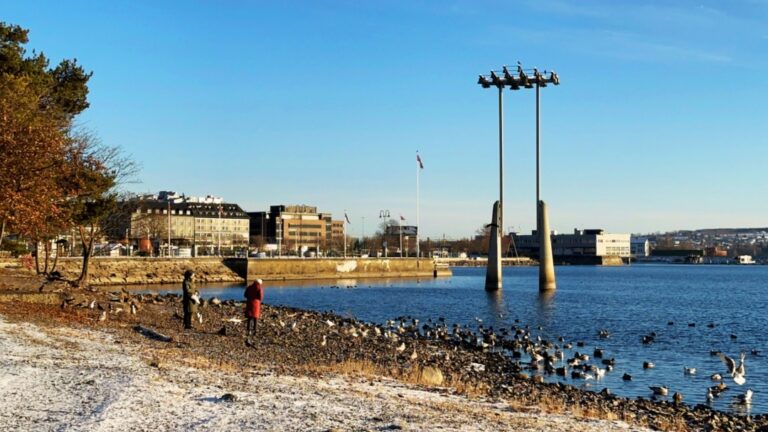
The waterfront has been nicely developed with various parklands, walking paths and other features. It’s here you’ll also find the 1950s diving platfom Stupetårnet. This recreation site turned historic monument has become a symbol of sorts of the city.
Vikingskipet
Vikingskipet, also known as the Hamar Olympic Hall, is a notable landmark in Hamar. Built for the 1994 Winter Olympics, it resembles a Viking ship, hence its name.
Today, it serves as a multi-purpose venue, hosting everything from sports events to concerts and exhibitions, although its primary use as an ice skating hall remains. It’s open for this purpose whenever they aren’t other events.
If you’re not a skater, you’re able to visit the arena during opening hours for a small fee. There’s a small exhibition about Lake Mjøsa in the spectator area, along with a cafe. A small sports shop is located in the reception area, primarily selling ice skating equipment and clothing.
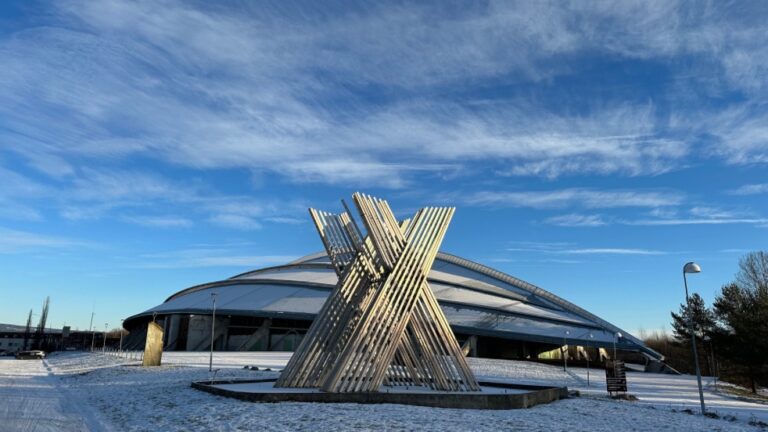
One of the more curious events taking place at Vikingskipet is The Gathering. The annual event for young people interested in IT takes place every Easter.
Cathedral Ruins and Folk Museum
Just to the northwest of modern Hamar, the ruins of the old Hamar Cathedral (Domkirkeodden) are a poignant reminder of Hamar’s medieval past. Dating back to the 12th century, the cathedral was a significant religious centre until its destruction in the 1560s.
Its location at the highest point of the headland was significant. The cathedral would have made an imposing landmark, visible for many miles away when sailing on Lake Mjøsa. Next to the cathedral ruins are the remains of the medieval settlement.
Today, the ruins are protected by a glass enclosure, allowing visitors to appreciate the history in all weather conditions. That being said, the museum is closed during some of the winter months, including on my visit. Next time!
The site is also home to a folk museum featuring 18th and 19th century farmhouses and other wooden buildings from across the region.
Norwegian Railway Museum
Given Hamar’s importance as a railway junction, it seems fitting the Norwegian Railway Museum is located here. It’s a must-visit for history and/or transport enthusiasts, although opening hours are limited.
Live Sport in Hamar
Unusually for a city so small, Hamar is home to professional sports clubs playing at the highest level of both ice hockey and football.
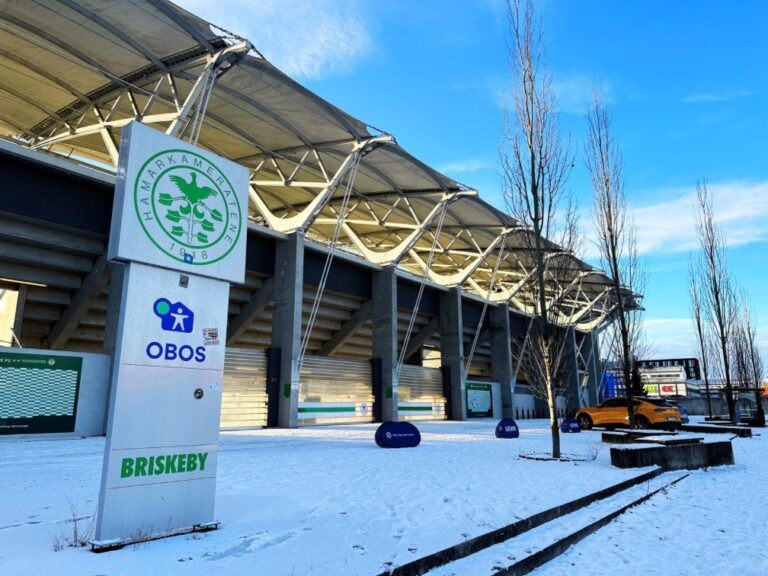
Storhamar Hockey
Another venue built for the 1994 Winter Olympics remains in use today. Nordlyshallen (CC Amfi) hosted short track speed skating and figure skating, but today it’s the home arena for Storhamar Hockey.
Since its creation in 1957, the club has won seven regular season titles and seven national championships. However, Storhamar’s only championship win in recent times came in the 2017-18 season. They have featured in the play-off final on three ocassions since then, though.
HamKam Football
Hamarkameratene, more commonly known as HamKam, is the city’s main football club with a history dating back to 1918. Promoted back to Eliteserien in 2021, the club has managed to hold its place in Norway’s top level in both 2022 and 2023.
The club plays its home games at Briskeby, a stadium with a chequered financial history. It seats just over 7,000 people.
Living in Hamar
Agriculture and forestry, the service industry, and biotechnology are the main industries in Hamar and the surrounding region. Building & construction, media, and communication are also represented.
Leading employers include Tine, Moelven Industrier, Eidsiva Energi, Sykehuset Innlandet, Sparebanken Hedmark, and Norsk Tipping. There’s also an emerging if small ecosystem of game development and VR/AR (XR) companies.
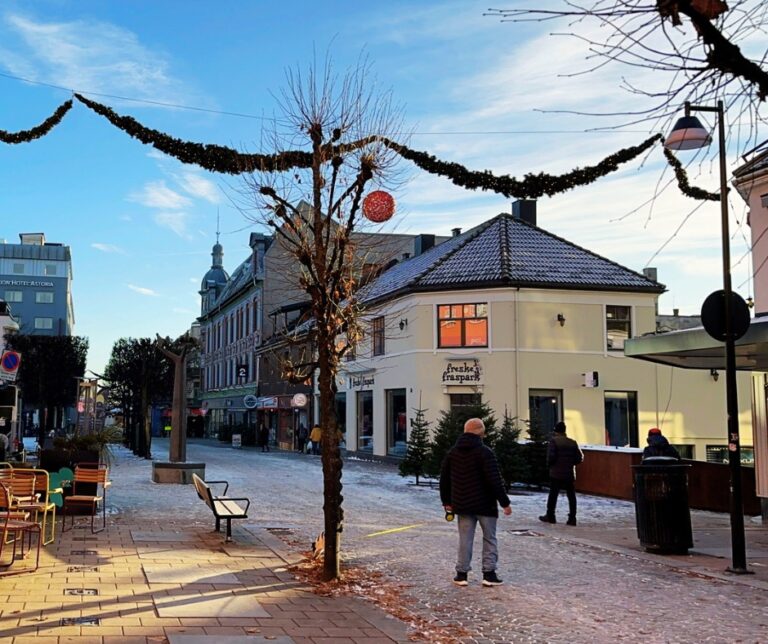
Upper secondary schools in the region include Storhamar school, Hamar cathedral school, and Stange school. International schools in the surrounding region include Gjøvikregionen international school (primary and secondary) and Elverum upper secondary school.
Residents of Hamar generally don’t need to leave the city for any of their shopping needs. Just to the north/northeast of the city centre, within walking distance, is a large indoor shopping centre CC Hamar. There’s another large mall in the western part of the city.
Getting to Hamar
Given the importance of Hamar on the Norwegian railway network, many people visiting will arrive by Hamar on the train. The Oslo to Lillehammer train calls at Hamar and runs hourly, and every half-hour at peak-times. It takes about 75 minutes.
Direct trains are also available to Hamar from Oslo Airport, Trondheim, Røros, and Elverum.
By road, the drive on Norway’s E6 takes approximately 90 minutes from downtown Oslo.
Where to Stay in Hamar
There are a handful of accommodation options in Hamar. If you want to stay close to the downtown area and train station, consider the Thon Hotel Victoria.
For those visiting Briskeby Stadium or Vikingskipet, consider the Scandic Hamar. This hotel is geared up for conferences and events, but there are often good offers for ‘ordinary’ travellers too. I stayed here and you can read my thoughts here.
Have you been to Hamar? Perhaps you even live there? Let’s hear about your experiences in the comments, below.


Are there northern lights during winter in Hamar?